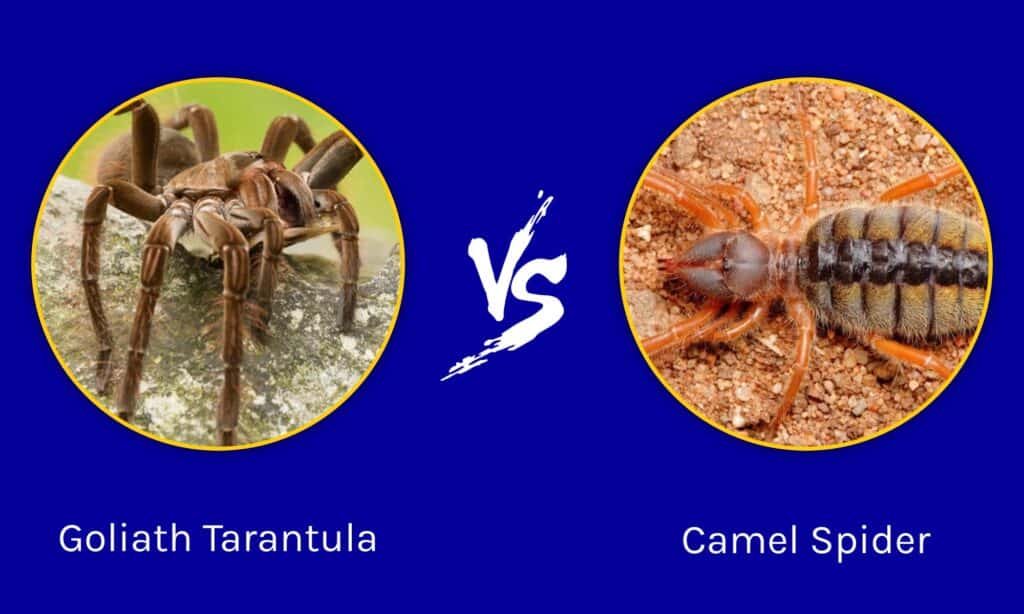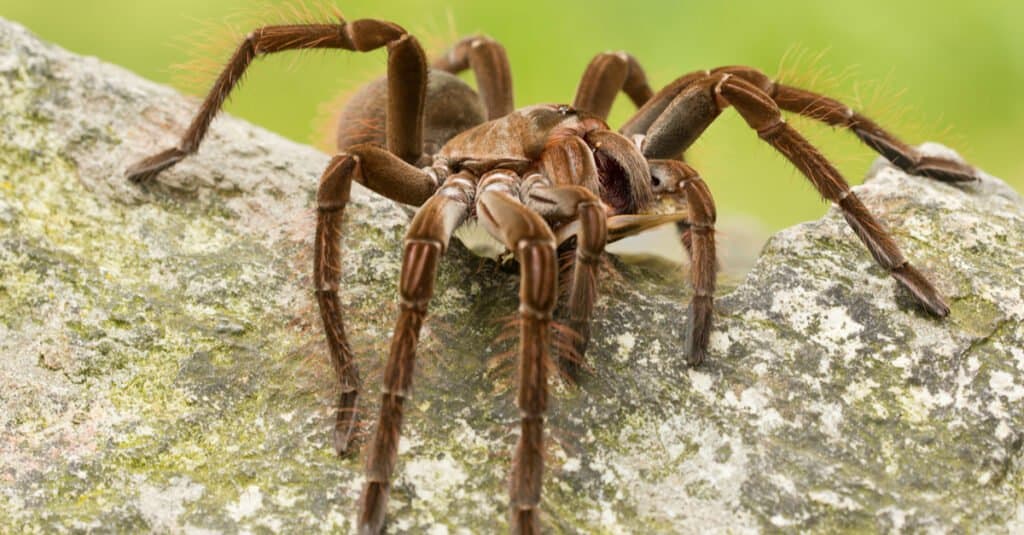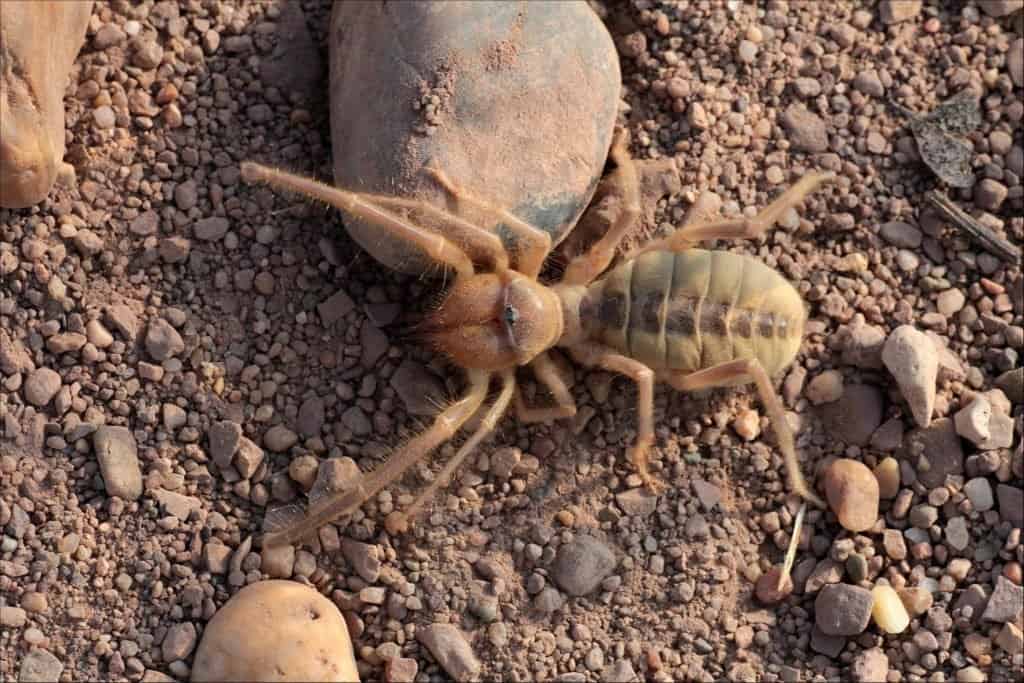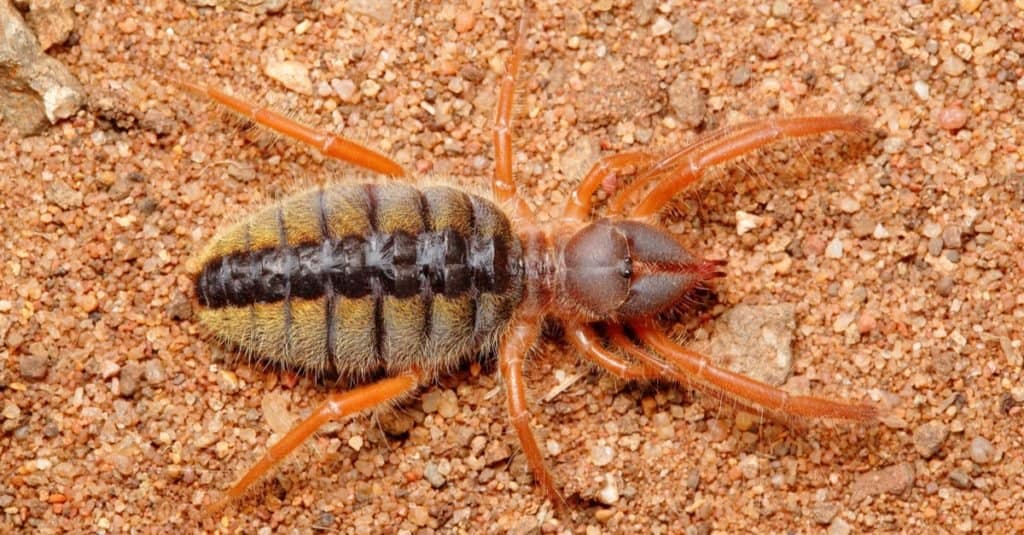Goliath tarantulas (Theraphosa blondi) are Theraphosidae. Though sometimes called Goliath bird eaters, these critters rarely eat birds. Camel spiders, sometimes called wind scorpions or Egyptian giant solpugids, are often confused with this spider due to incorrect information online. Although they’re both arachnids, they share relatively few similarities. Arachnida include both spiders (tarantulas) and camel spiders. So, how can you tell these creatures apart? In this article, we’ll compare these two critters. Join us in this Goliath tarantula vs. camel spider investigation!
Goliath Tarantula vs. Camel Spider: A Comparison

| Goliath Tarantula | Camel Spider | |
|---|---|---|
| Size | Up to 11 inches | Up to 6 inches |
| Colors | Light Brown with Golden Blonde Hue | Tan to Dark Brown |
| Features | 8 legs, Big Hairy Abdomen, Long Fangs | 8 Legs and 2 Pedipalps; Crab-Like Pincers |
| Habitats | Northern South American Rainforests | Widespread; Deserts, Meadows, Marshlands |
| Habits | Solitary, Nocturnal, Like to Burrow | Solitary, Nocturnal, Some Cannibalize when Meeting or Mating |
| Diet | Opportunistic eater: Carrion, Insects. | Termites, Insects, Snakes, Rodents |
| Venomous | Mild Venom, Can Dry Bite | Can Bite, No Venom |
| Lifespan | Up to 25 Years | Up to One Year |
Key Differences Between Goliath Tarantula vs. Camel Spider

Camel spiders are not actually spiders, but a new world arachnid of its own kind.
©wacpan/Shutterstock.com
The key differences between a Goliath tarantula and a camel spider are size, classification, habitat, possession of venom, habits, appearance, and lifespan.
As far as mass and size are concerned, Goliath tarantulas are the biggest spiders in the animal kingdom. Camel spiders are actually not spiders at all. They are Solifugae arachnids, a new species of arachnids. A variety of other names for these scorpion-like creatures exist, including sun spider and wind scorpion. Let’s have a look at some distinctions!
Size

The Goliath tarantula has a maximum leg span of 11 inches.
©Milan Zygmunt/Shutterstock.com
When its legs are spread out, Goliath tarantulas can measure up to 11 inches in diameter and weigh up to 6 ounces of weight. More than a thousand different species of camel spiders have been identified. They can grow up to 6 inches in length, including their legs.
Colors
Dark and light brown are the primary colors of the Goliath tarantula. This tarantula is named blondi because of its golden hue. A camel spider has a tan to dark brown in appearance, with fine hairs covering its body. A camel spider’s thin hairs help to keep it cool in the desert. Creatures like camel spiders and goliath tarantulas can blend in well with their surroundings because of their brown hues.
Features

The Goliath tarantula has inch-long fangs that inject toxins into a prey’s bloodstream.
©Milan Zygmunt/Shutterstock.com
A huge abdomen and smaller cephalothorax are typical characteristics of all tarantulas, including Goliaths. At the end of its hairy abdomen, this spider has spinnerets, and at the front of its cephalothorax are fangs. Their fangs are extremely big and can reach 1.5 inch in length.
Camel spiders look like spiders, but they look to have five pairs of legs. Its first set of “legs” are pedipalps, which are tiny extensions near the mouth that aid in feeding. The hair and feathers of dead animals are torn off by the chelicerae’s crab-like pincers.
Habitat
Goliath tarantulas are found in the upland rainforests of northern South America. During the night, they live in marshy places, where they dig deep into the ground. Camel spiders are widespread, apart from Australia and Antarctica. On the continents they inhabit, they live in desert regions. Occasionally, species inhabit meadows and woodlands. They enjoy warm, arid environments and avoid cold.
Habits

Camel spiders live in desert regions and despise cold climates.
©Dmitry Fch/Shutterstock.com
Goliath tarantulas are nocturnal, terrestrial animals that live in deep tunnels in marshes. In soft, moist soil, they build holes to hide. During the day, they sleep in their burrow, at night they emerge to hunt. Solitary critters, they only interact to reproduce. Unlike many other arachnids, their females don’t kill and eat potential mates.
Different camel spider species have different behaviors. Many of these desert creatures are nocturnal to avoid the extreme heat. The majority are solitary and only interact for reproduction. Some species cannibalize or fight when they meet.
Diet
When the Goliath tarantula was originally discovered, it was thought to be feeding on a bird, hence the name “Goliath.” For the Goliath tarantula, birds are not its major prey. This spider is a voracious eater who will take advantage of any food opportunity that presents itself. It’s capable of catching roaches, live crickets, mealworms, and other insects with ease.
Camel spiders normally eat termites and other small insects, but they can also eat snakes, rodents, and lizards when challenged. Prey is broken into little pieces by their chelicerae, or jaws before they are liquefied and absorbed.
Venom

The Goliath injects its prey with a juice that liquefies all but the skin and bones.
©iStock.com/Dan Olsen
Goliath tarantula venom is moderate and not medically significant, but the bite is painful enough to make people wary of touching them. These harmless spiders are occasionally kept as pets. They have minor venom in their bites and irritant hairs. The mature tarantula’s inch-long fangs develop with each molt. They can also deliver a dry bite. This puncture causes discomfort but yields no venom. Camel spider attacks are rare, but their powerful jaws can tear through human skin when attacked. Luckily, they’re not venomous and won’t kill you.
Lifespan
Amazingly, female Goliaths can live up to 25 years in captivity, whereas males live around three to six years. Camel spiders only average a year.
Wrapping Up Goliath Tarantula vs. Camel Spider

Camel spiders are vicious predators that eat insects, rodents, lizards, and small birds.
©Ondrej Michalek/Shutterstock.com
Now that you understand the key differences between the Goliath tarantula and camel spider, hopefully, you will be able to spot what is what if you come across one! Due to their environmental choices, both species rarely interact with humans and therefore, rarely bite. It is typically out of fear that humans will kill these creatures. If you are out in nature and come across one of these critters, back away and leave them alone. They don’t want to be disturbed or bother you.
The photo featured at the top of this post is © iStock.com/Willem Van Zyl
Thank you for reading! Have some feedback for us? Contact the AZ Animals editorial team.







